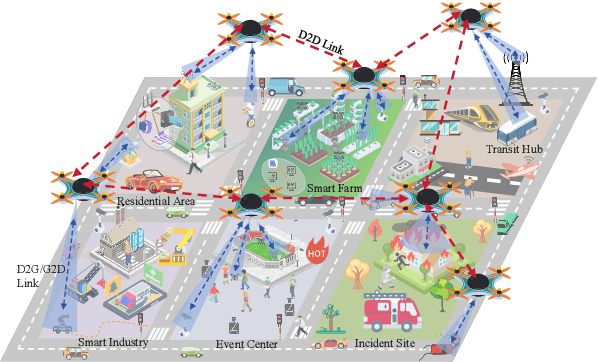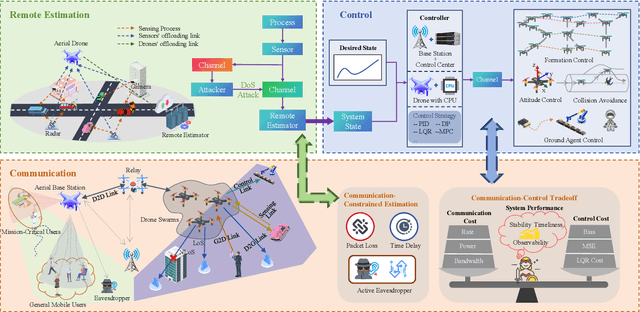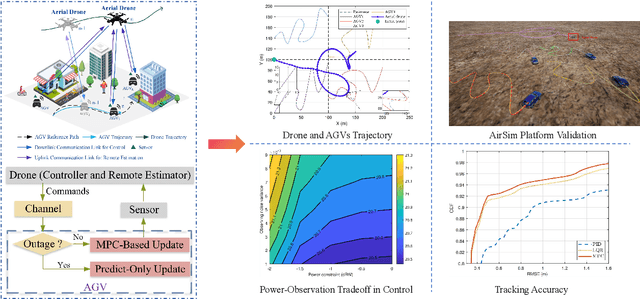Weijie Yuan
Integrated Sensing and Communication: Towards Multifunctional Perceptive Network
Oct 16, 2025Abstract:The capacity-maximization design philosophy has driven the growth of wireless networks for decades. However, with the slowdown in recent data traffic demand, the mobile industry can no longer rely solely on communication services to sustain development. In response, Integrated Sensing and Communications (ISAC) has emerged as a transformative solution, embedding sensing capabilities into communication networks to enable multifunctional wireless systems. This paradigm shift expands the role of networks from sole data transmission to versatile platforms supporting diverse applications. In this review, we provide a bird's-eye view of ISAC for new researchers, highlighting key challenges, opportunities, and application scenarios to guide future exploration in this field.
The Role of ISAC in 6G Networks: Enabling Next-Generation Wireless Systems
Oct 06, 2025Abstract:The commencement of the sixth-generation (6G) wireless networks represents a fundamental shift in the integration of communication and sensing technologies to support next-generation applications. Integrated sensing and communication (ISAC) is a key concept in this evolution, enabling end-to-end support for both communication and sensing within a unified framework. It enhances spectrum efficiency, reduces latency, and supports diverse use cases, including smart cities, autonomous systems, and perceptive environments. This tutorial provides a comprehensive overview of ISAC's role in 6G networks, beginning with its evolution since 5G and the technical drivers behind its adoption. Core principles and system variations of ISAC are introduced, followed by an in-depth discussion of the enabling technologies that facilitate its practical deployment. The paper further analyzes current research directions to highlight key challenges, open issues, and emerging trends. Design insights and recommendations are also presented to support future development and implementation. This work ultimately try to address three central questions: Why is ISAC essential for 6G? What innovations does it bring? How will it shape the future of wireless communication?
Joint AoI and Handover Optimization in Space-Air-Ground Integrated Network
Sep 16, 2025Abstract:Despite the widespread deployment of terrestrial networks, providing reliable communication services to remote areas and maintaining connectivity during emergencies remains challenging. Low Earth orbit (LEO) satellite constellations offer promising solutions with their global coverage capabilities and reduced latency, yet struggle with intermittent coverage and limited communication windows due to orbital dynamics. This paper introduces an age of information (AoI)-aware space-air-ground integrated network (SAGIN) architecture that leverages a high-altitude platform (HAP) as intelligent relay between the LEO satellites and ground terminals. Our three-layer design employs hybrid free-space optical (FSO) links for high-capacity satellite-to-HAP communication and reliable radio frequency (RF) links for HAP-to-ground transmission, and thus addressing the temporal discontinuity in LEO satellite coverage while serving diverse user priorities. Specifically, we formulate a joint optimization problem to simultaneously minimize the AoI and satellite handover frequency through optimal transmit power distribution and satellite selection decisions. This highly dynamic, non-convex problem with time-coupled constraints presents significant computational challenges for traditional approaches. To address these difficulties, we propose a novel diffusion model (DM)-enhanced dueling double deep Q-network with action decomposition and state transformer encoder (DD3QN-AS) algorithm that incorporates transformer-based temporal feature extraction and employs a DM-based latent prompt generative module to refine state-action representations through conditional denoising. Simulation results highlight the superior performance of the proposed approach compared with policy-based methods and some other deep reinforcement learning (DRL) benchmarks.
Toward Multi-Functional LAWNs with ISAC: Opportunities, Challenges, and the Road Ahead
Aug 24, 2025



Abstract:Integrated sensing and communication (ISAC) has been envisioned as a foundational technology for future low-altitude wireless networks (LAWNs), enabling real-time environmental perception and data exchange across aerial-ground systems. In this article, we first explore the roles of ISAC in LAWNs from both node-level and network-level perspectives. We highlight the performance gains achieved through hierarchical integration and cooperation, wherein key design trade-offs are demonstrated. Apart from physical-layer enhancements, emerging LAWN applications demand broader functionalities. To this end, we propose a multi-functional LAWN framework that extends ISAC with capabilities in control, computation, wireless power transfer, and large language model (LLM)-based intelligence. We further provide a representative case study to present the benefits of ISAC-enabled LAWNs and the promising research directions are finally outlined.
Jamming Identification with Differential Transformer for Low-Altitude Wireless Networks
Aug 17, 2025Abstract:Wireless jamming identification, which detects and classifies electromagnetic jamming from non-cooperative devices, is crucial for emerging low-altitude wireless networks consisting of many drone terminals that are highly susceptible to electromagnetic jamming. However, jamming identification schemes adopting deep learning (DL) are vulnerable to attacks involving carefully crafted adversarial samples, resulting in inevitable robustness degradation. To address this issue, we propose a differential transformer framework for wireless jamming identification. Firstly, we introduce a differential transformer network in order to distinguish jamming signals, which overcomes the attention noise when compared with its traditional counterpart by performing self-attention operations in a differential manner. Secondly, we propose a randomized masking training strategy to improve network robustness, which leverages the patch partitioning mechanism inherent to transformer architectures in order to create parallel feature extraction branches. Each branch operates on a distinct, randomly masked subset of patches, which fundamentally constrains the propagation of adversarial perturbations across the network. Additionally, the ensemble effect generated by fusing predictions from these diverse branches demonstrates superior resilience against adversarial attacks. Finally, we introduce a novel consistent training framework that significantly enhances adversarial robustness through dualbranch regularization. Simulation results demonstrate that our proposed methodology is superior to existing methods in boosting robustness to adversarial samples.
Advancing the Control of Low-Altitude Wireless Networks: Architecture, Design Principles, and Future Directions
Aug 11, 2025



Abstract:This article introduces a control-oriented low-altitude wireless network (LAWN) that integrates near-ground communications and remote estimation of the internal system state. This integration supports reliable networked control in dynamic aerial-ground environments. First, we introduce the network's modular architecture and key performance metrics. Then, we discuss core design trade-offs across the control, communication, and estimation layers. A case study illustrates closed-loop coordination under wireless constraints. Finally, we outline future directions for scalable, resilient LAWN deployments in real-time and resource-constrained scenarios.
Large AI Model-Enabled Secure Communications in Low-Altitude Wireless Networks: Concepts, Perspectives and Case Study
Aug 01, 2025Abstract:Low-altitude wireless networks (LAWNs) have the potential to revolutionize communications by supporting a range of applications, including urban parcel delivery, aerial inspections and air taxis. However, compared with traditional wireless networks, LAWNs face unique security challenges due to low-altitude operations, frequent mobility and reliance on unlicensed spectrum, making it more vulnerable to some malicious attacks. In this paper, we investigate some large artificial intelligence model (LAM)-enabled solutions for secure communications in LAWNs. Specifically, we first explore the amplified security risks and important limitations of traditional AI methods in LAWNs. Then, we introduce the basic concepts of LAMs and delve into the role of LAMs in addressing these challenges. To demonstrate the practical benefits of LAMs for secure communications in LAWNs, we propose a novel LAM-based optimization framework that leverages large language models (LLMs) to generate enhanced state features on top of handcrafted representations, and to design intrinsic rewards accordingly, thereby improving reinforcement learning performance for secure communication tasks. Through a typical case study, simulation results validate the effectiveness of the proposed framework. Finally, we outline future directions for integrating LAMs into secure LAWN applications.
Predictive Control over LAWN: Joint Trajectory Design and Resource Allocation
Jul 03, 2025Abstract:Low-altitude wireless networks (LAWNs) have been envisioned as flexible and transformative platforms for enabling delay-sensitive control applications in Internet of Things (IoT) systems. In this work, we investigate the real-time wireless control over a LAWN system, where an aerial drone is employed to serve multiple mobile automated guided vehicles (AGVs) via finite blocklength (FBL) transmission. Toward this end, we adopt the model predictive control (MPC) to ensure accurate trajectory tracking, while we analyze the communication reliability using the outage probability. Subsequently, we formulate an optimization problem to jointly determine control policy, transmit power allocation, and drone trajectory by accounting for the maximum travel distance and control input constraints. To address the resultant non-convex optimization problem, we first derive the closed-form expression of the outage probability under FBL transmission. Based on this, we reformulate the original problem as a quadratic programming (QP) problem, followed by developing an alternating optimization (AO) framework. Specifically, we employ the projected gradient descent (PGD) method and the successive convex approximation (SCA) technique to achieve computationally efficient sub-optimal solutions. Furthermore, we thoroughly analyze the convergence and computational complexity of the proposed algorithm. Extensive simulations and AirSim-based experiments are conducted to validate the superiority of our proposed approach compared to the baseline schemes in terms of control performance.
SDR-Empowered Environment Sensing Design and Experimental Validation Using OTFS-ISAC Signals
Jul 02, 2025Abstract:This paper investigates the system design and experimental validation of integrated sensing and communication (ISAC) for environmental sensing, which is expected to be a critical enabler for next-generation wireless networks. We advocate exploiting orthogonal time frequency space (OTFS) modulation for its inherent sparsity and stability in delay-Doppler (DD) domain channels, facilitating a low-overhead environment sensing design. Moreover, a comprehensive environmental sensing framework is developed, encompassing DD domain channel estimation, target localization, and experimental validation. In particular, we first explore the OTFS channel estimation in the presence of fractional delay and Doppler shifts. Given the estimated parameters, we propose a three-ellipse positioning algorithm to localize the target's position, followed by determining the mobile transmitter's velocity. Additionally, to evaluate the performance of our proposed design, we conduct extensive simulations and experiments using a software-defined radio (SDR)-based platform with universal software radio peripheral (USRP). The experimental validations demonstrate that our proposed approach outperforms the benchmarks in terms of localization accuracy and velocity estimation, confirming its effectiveness in practical environmental sensing applications.
Co-Design of Sensing, Communications, and Control for Low-Altitude Wireless Networks
Jun 26, 2025



Abstract:The rapid advancement of Internet of Things (IoT) services and the evolution toward the sixth generation (6G) have positioned unmanned aerial vehicles (UAVs) as critical enablers of low-altitude wireless networks (LAWNs). This work investigates the co-design of integrated sensing, communication, and control ($\mathbf{SC^{2}}$) for multi-UAV cooperative systems with finite blocklength (FBL) transmission. In particular, the UAVs continuously monitor the state of the field robots and transmit their observations to the robot controller to ensure stable control while cooperating to localize an unknown sensing target (ST). To this end, a weighted optimization problem is first formulated by jointly considering the control and localization performance in terms of the linear quadratic regulator (LQR) cost and the determinant of the Fisher information matrix (FIM), respectively. The resultant problem, optimizing resource allocations, the UAVs' deployment positions, and multi-user scheduling, is non-convex. To circumvent this challenge, we first derive a closed-form expression of the LQR cost with respect to other variables. Subsequently, the non-convex optimization problem is decomposed into a series of sub-problems by leveraging the alternating optimization (AO) approach, in which the difference of convex functions (DC) programming and projected gradient descent (PGD) method are employed to obtain an efficient near-optimal solution. Furthermore, the convergence and computational complexity of the proposed algorithm are thoroughly analyzed. Extensive simulation results are presented to validate the effectiveness of our proposed approach compared to the benchmark schemes and reveal the trade-off between control and sensing performance.
 Add to Chrome
Add to Chrome Add to Firefox
Add to Firefox Add to Edge
Add to Edge